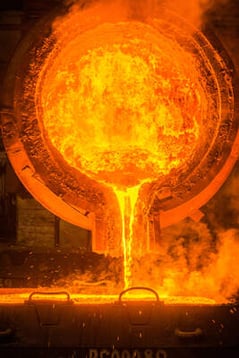The Best Methods for Manufacturing Steel Fittings
Forged fittings are far superior to other processes in the majority of applications. The forging process provides consistency in the structure and composition of the materials, and the metallurgical recrystalisation and grain refinement strengthens steel products, particularly for shear, impact and strength.
Forged steel is stronger and more reliable than brazing, casting and plate steel because the grain structure of the steel is altered, conforming to the shape of the part.
Some of the leading advantages of forged fittings include:
- The tight grain structure makes them mechanically stronger than alternative methods
- Low cost due to less waste of excess flashing and ability to produce near-net shapes
- Exclusion of porosity, cavities, shrinkage and cold pour issues
- Less need for expensive alloys to manufacture high strength components
- Greater wear resistance and longer service life of the fitting
- Does not require a special skilled operator to produce
- Wider variety of solid body shapes can be produced
- Superior ability to withstand impact over brazed or casted fittings
 Forged Fittings vs Brazed Fittings: The Difference
Forged Fittings vs Brazed Fittings: The Difference
Forged Fittings
Forged fittings are made from one piece of metal, which allows them to be produced with less material providing a more compact design and smaller wrench flat. Most forged fittings are made using a hot forging process which heats the metal above its recrystallization temperature, providing for the annealing process to obtain growth of new grains in the metal without phase change.
In other words, hot forging is a metal shaping process which takes a malleable metal part, such as a billet or other metal workpiece and heats up to about 75% of its melting temperature. It is then worked, or essentially molded, to a predetermined shape in a die.
Brazed Fittings
Brazed fittings are made from multiple, pre-machined components that are combined together, resulting in a finished part. Though the brazing process can allow for fittings with some customization when combining multiple components, they are susceptible to fatigue at the joints. Most brazed fittings are made by furnace brazing, which can generate a large number of parts on a continuous belt in a controlled heat cycle and atmosphere. However, extra steps such as ensuring very close fits are necessary to facilitate the capillary action in the brazing process and secondary component parts are annealed during the process. In addition, provisions must be made in the design process for the location and fit of the brazed components.
This blog is an excerpt from our whitepaper, The Advantages of Forged Fittings. Click the link below to download your free whitepaper!
Primary Sources Include:
- ATC GROUP
- Boss Industrial
- CFS Forge
- CFS Forge 2
- ClubTechnical Mechanical Engineering blog
- Hydraulics & Pneumatics
- ScienceDirect
- Viking Forge

